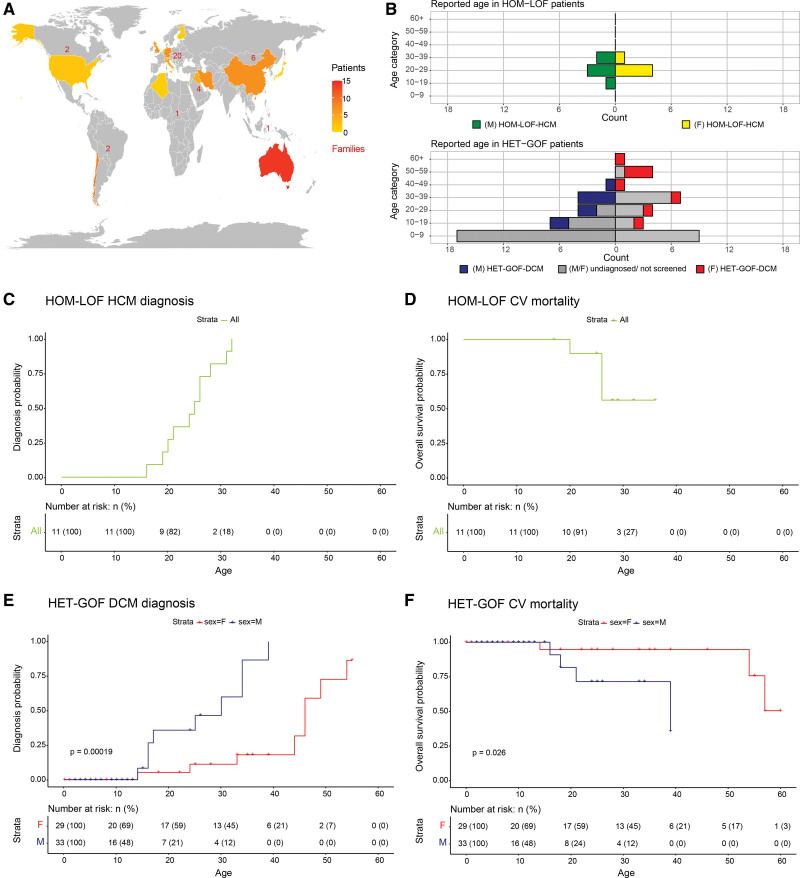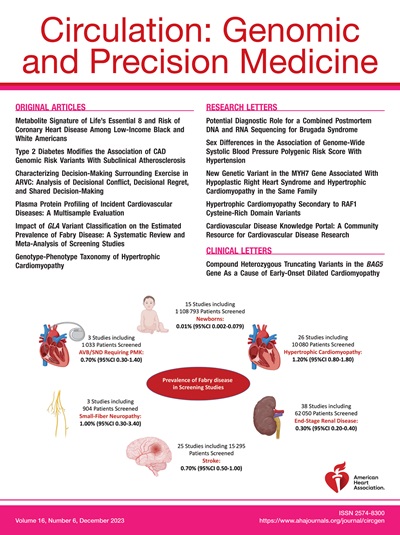Clinical Outcome in KLHL24 Cardiomyopathy.
IF 6
2区 医学
Q1 CARDIAC & CARDIOVASCULAR SYSTEMS
引用次数: 1
Abstract
Pathogenic variants in Kelch-like family member 24 (KLHL24; NM_017644.3) were recently identified as a new cause for skin fragility and cardiomyopathy. KLHL24 is part of a ubiquitin-ligase complex and mediates substrate recognition of intermediate filaments for proteasomal degradation (ie, keratins,1,2 vimentin,2 and desmin3,4). Several studies have shown that patients with heterozygous gain-of-function variants (HET-GOF), typically born with epidermolysis bullosa simplex,1,2 can develop dilated cardiomyopathy (DCM) with desmin-deficiency.3 Meanwhile, hypertrophic cardiomyopathy (HCM) with desmin-overload has been determined in patients with homozygous loss-of-function variants (HOM-LOF).4 This meta-analysis aims to summarize the findings of previous patient studies to determine the clinical outcome in KLHL24 cardiomyopathy. Observational studies (2016–2022) on KLHL24 found in PUBMED were included in this analysis. The data are available from the corresponding authors upon reasonable request. Meanwhile, an Institutional Review Board approval for this study was not required, as this is a meta-analysis. Patients were stratified according to their genotype (HOM-LOF and HET-GOF) and the study outcomes were cardiomyopathy diagnosis and cardiovascular events. Cardiovascular events were defined as sudden cardiac death, death from heart failure, or heart transplantation. Kaplan-Meier curves were constructed to visualize the age at diagnosis and cardiovascular event free-survival. For the HET-GOF group, this analysis was stratified by sex, and log-rank testing was used to test for significant differences in the distribution. To achieve between-group balance, the sex-stratified Kaplan-Meier curves were weighted for age and cohort. In total, 73 patients from 14 studies were included in this analysis, and Figure (A) shows their geographic distribution. In general, patients had a median age (interquartile range) of 18 (7–33) years, at the time of the respected study publication. Fifty-three percent were men, 38% were diagnosed with cardiomyopathy, and 84% were patients with HET-GOF variants. Patients with HOM-LOF variants had a median age of 27 (26– 31) years, and 55% were male (Figure [B]). HOM-LOF variants c.917G>A (p.[Arg306His]) and c.1048G>T (p.[Glu350*]) segregated in 2 Middle-Eastern families, reporting 11 patients born from seemingly unaffected consanguineous heterozygous parents. All patients with HOM-LOF were diagnosed with HCM before the age of 32 (27 [26–31]; Figure [C]), resulting in 4 cardiovascular events (sudden cardiac death n=3; heart transplantation n=1; Figure [D]). Patients with HET-GOF variants have a median age of 14 [6–33] and 53% were men (Figure [B]). HET-GOF variants c.1A>G, c.1A>T, c.2T>C, c.3G>T, c.3G>A and c.22A>T (p.[Val2_Met29del]) segregated with disease in 34 families, reporting 62 patients in 14 countries. All patients with HET-GOF had epidermolysis bullosa simplex at birth, and 27% were diagnosed with DCM. The probability of diagnosing DCM during lifetime was significantly different (P<0.001, weighted

KLHL24心肌病的临床结局。
本文章由计算机程序翻译,如有差异,请以英文原文为准。
求助全文
约1分钟内获得全文
求助全文
来源期刊

Circulation: Genomic and Precision Medicine
Biochemistry, Genetics and Molecular Biology-Genetics
CiteScore
9.20
自引率
5.40%
发文量
144
期刊介绍:
Circulation: Genomic and Precision Medicine is a distinguished journal dedicated to advancing the frontiers of cardiovascular genomics and precision medicine. It publishes a diverse array of original research articles that delve into the genetic and molecular underpinnings of cardiovascular diseases. The journal's scope is broad, encompassing studies from human subjects to laboratory models, and from in vitro experiments to computational simulations.
Circulation: Genomic and Precision Medicine is committed to publishing studies that have direct relevance to human cardiovascular biology and disease, with the ultimate goal of improving patient care and outcomes. The journal serves as a platform for researchers to share their groundbreaking work, fostering collaboration and innovation in the field of cardiovascular genomics and precision medicine.
 求助内容:
求助内容: 应助结果提醒方式:
应助结果提醒方式:


